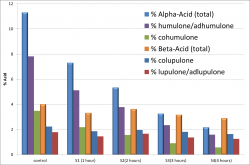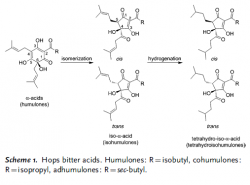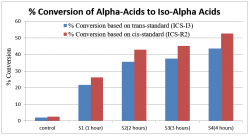Difference between revisions of "Hop Isomerization"
| Line 35: | Line 35: | ||
=Results= | =Results= | ||
| − | + | ||
| − | + | ||
| − | |||
Significant time was invested in HPLC methodology development in order to optimize peak resolution on the chromatograph. The primary challenge was developing a method which would allow the characterization of both the α-acids and iso-α-acids. (Figure 2) A gradient method was ultimately developed which would allow a single trial to be completed within 35 minutes on a waters HPLC System using a Supelco Analytical Supelcosil LC-18 25cm 4.6mm, 5mm HPLC column. 10 μl injections were introduced to the column at 28 ⁰C with a gradient mobile phase: 65% MeOH 0-12 min, then up to 85% MeOH by 18 min, hold at 85% until 28 min, then back to 65% MeOH at 33 min. UV detection was focused on peak resolution at 270nm.1, 2 | Significant time was invested in HPLC methodology development in order to optimize peak resolution on the chromatograph. The primary challenge was developing a method which would allow the characterization of both the α-acids and iso-α-acids. (Figure 2) A gradient method was ultimately developed which would allow a single trial to be completed within 35 minutes on a waters HPLC System using a Supelco Analytical Supelcosil LC-18 25cm 4.6mm, 5mm HPLC column. 10 μl injections were introduced to the column at 28 ⁰C with a gradient mobile phase: 65% MeOH 0-12 min, then up to 85% MeOH by 18 min, hold at 85% until 28 min, then back to 65% MeOH at 33 min. UV detection was focused on peak resolution at 270nm.1, 2 | ||
| + | [[File:Results.jpg|thumb|250px|frame|center|'''Figure 2:''' Reverse-phase high performance liquid chromatography (HPLC) with UV detection at 270 nm chromatographs depicting ASBC standards in comparison to a heat treated sample of Chinook hops. A Waters HPLC System was employed using a Supelco Analytical Supelcosil LC-18 25cm 4.6mm, 5mm HPLC column. 10 μl injections were introduced to the column at 28 ⁰C with a gradient mobile phase: 65% MeOH 0-12 min, then up to 85% MeOH by 18 min, hold at 85% until 28 min, then back to 65% MeOH at 33 min. 1,2]] | ||
| + | Once the HPLC method was confirmed through acceptable peak resolution of hop standards, analysis was conducted on Chinook samples which had been previously heat treated and extracted. The HPLC chromatographs depict α and β acid content of Chinook Hop sample extractions. (Figure 3) The α and β acid peaks elute around the 20 minute mark. The first two peaks, of four, around the 20 minute mark are attributed to α-acids. The final two peaks are -acids. This series of chromatographs show a reduction of α-acid upon heat treatment that is dependent on treatment length. In conjunction with the reduction of α-acids, these chromatographs also show an increase in sub 10 minute peaks attributable to the formation of iso-α-acids. | ||
| − | + | [[File:Results2.jpg|thumb|250px|frame|center| | |
| + | '''Figure 3:''' Reverse-phase high performance liquid chromatography (HPLC) chromatographs depicting α and β acid content of Chinook Hop sample extractions. The α and β acid peaks elute around the 20 minute mark. The first two peaks, of four, around the 20 minute mark are attributed to α-acids. The final two peaks are β-acids. This series of chromatographs show a reduction of α-acid upon heat treatment that is dependent on treatment length. In conjunction with the reduction of α-acids, these chromatographs also show an increase in sub 10 minute peaks attributable to the formation of iso-α-acids.]] | ||
=Discussion= | =Discussion= | ||
Revision as of 19:23, 19 April 2016
Chris J. Knutson Monmouth College 5/13/2015
Isomerization of Humulus Lupulus α-Acids
To Do
- Fix all the alpha (α) boxes
- Fix all the alpha (β) boxes
- Fix all the citations
- Fix all the micro (μ) boxes
- Fix all the figures
Abstract
Hops are added to the brew kettle at different times in order to add specific character to the beer. The addition of hops early in the boiling process (early addition) primarily add bitterness; while the addition of hops late in the boiling process (late addition) primarily flavor and aroma. Hop bitterness comes from the isomerization of α-acids with effective utilization of not more than 30%. The reason for low utilization is most likely a combination of factors related to both the volatility of the α-acids as well as degradation of the isomerized α-acids. The contribution of late addition hops to the final beer is a result of essential oils and is not fully understood. Recipe formulations which have a strong hop flavor component add hops throughout the brewing process as well as after primary fermentation (dry hopping). This research developed a method of pre-isomerizing hop α-acids in order to increase utilization efficiency as well as a method of high performance liquid chromatography (HPLC) analysis of both the α-acids and iso-α-acids during a single injection. The data presented will show that hop utilization can be improved substantially through simply heat treating the hops before addition to the brewing process and that the isomerization reaction can be characterized using a universal HPLC method for both the starting and end products of the reaction.
Introduction
Humulus Lupulus (Hops) are a quantitatively minor component in the beer brewing process, but a qualitatively major component of the finished product. For every 1 US gallon (~4 L) of beer, 2 pounds (~ 1 kg) of grain and only 0.4 ounces (~ 10 g) of hops are needed. Beers that strive to highlight the malty character in a beer tend towards more grain, those looking to highlight “hop character” tend towards more hops. Whereas grains have always been a part of the beer recipe, it was not until the middle of the second millennium (~1500 CE) that hops became a commonly used brewing ingredient. Hops, like many spices, were added for flavor, but became common due to their yet to be discovered antibacterial properties. Note that beer in the earlier days was quite different from the modern versions and many needed something to cover up the less desirable characteristics.
Hops are added during the brewing process to contribute to three main characteristics to the beer: bitterness, flavor, and aroma. To achieve these characteristics, different hop varieties are selected and the hops are added to the boil kettle at different times. Hops added “early” in the 60 minute boil add bitterness; hops added “late” contribute to the flavor and aroma. The chemical composition of hops that add flavor and aroma are associated with essential oils that reside in the Lupulin glands of the hop flower (cone). Hops added early also contain these essential oils, but these oils are volatized in the boil kettle.5 It is understood that the bitterness associated with hops added early in the wort boiling process is a product of the isomerization of α-acids within the hop. Non-isomerized α-acids typically have a low solubility; however, once isomerized, α-acids take on a much more soluble iso-α-acid form.6 (Figure 1).
Hops can be a major financial investment in a beer. The wholesale price of grains (~$0.50/lb.; $1/kg) is considerably less than the price of hops (~$10/lb.; $20/kg). In the above example hops are ~1% of the recipe but cost ~2000% (x20) more than grain. As above, for every 1 US gallon (~4 L) of beer, $1 of grains and $0.25 of hops are needed. As with most business related activities, increasing the process efficiency is one means of lowering the production costs. Under standard brewing conditions, an estimate of 30% of the added a-acids are converted into iso-α-acids. The low utilization efficiency is a result of many factors including, the volatility of α-acids, the degradation of iso-α-acids, and the physical dynamics of the brewing process.3, 4, 5 The current strategy of increasing hop utilization in large scale industrial brewing is to mix hop pellets with a catalyst, such as magnesium oxide, and allow the hops to rest for a 8-12 days at 50C.7 This research sought to produce a pre-isomerization method for a small scale application which would not require the use of additional catalysts. We have undertaken a set of experiments to determine if we can pre-isomerize α-acids in the hop cone prior to the brewing process. Our approach involves the heating of packaged hop material at 100 ⁰C for 1,2,3,4 hours. Analysis of the α-acids and iso-α-acids is done by high performance liquid chromatography (HPLC).1, 2
Materials and Methods
Hop acid standards, methanol and concentrated hydrochloric acid were provided by Monmouth College and purchased from Sigma Aldrich. Water’s high performance liquid chromatography was supplied by Monmouth College. Chinook hops (bulk) were provided by Bradley E. Sturgeon. Samples of Chinook hops were packaged in heat sealable packaging and then heated in an oven at 100 ⁰C for a variable amount of time. Extractions were prepared using approximately 3g samples of Chinook hops in 150 ml of extraction solvent. The extraction solvent was 75% Methanol, 24% deionized H2O, 1% Concentrated HCl. The extractions were mechanically stirred for 1 hour and then filtered through a 0.45 μm filter and introduced to a Supelco Analytical Supelcosil LC-18 25cm 4.6mm, 5mm HPLC column in 10 μl injections. High performance liquid chromatography was conducted at 28 ⁰C with a gradient mobile phase: 65% MeOH 0-12 min, then up to 85% MeOH by 18 min, hold at 85% until 28 min, then back to 65% MeOH at 33 min. 1,2
Results
Significant time was invested in HPLC methodology development in order to optimize peak resolution on the chromatograph. The primary challenge was developing a method which would allow the characterization of both the α-acids and iso-α-acids. (Figure 2) A gradient method was ultimately developed which would allow a single trial to be completed within 35 minutes on a waters HPLC System using a Supelco Analytical Supelcosil LC-18 25cm 4.6mm, 5mm HPLC column. 10 μl injections were introduced to the column at 28 ⁰C with a gradient mobile phase: 65% MeOH 0-12 min, then up to 85% MeOH by 18 min, hold at 85% until 28 min, then back to 65% MeOH at 33 min. UV detection was focused on peak resolution at 270nm.1, 2
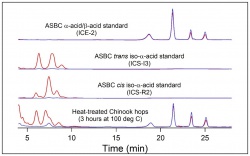
Once the HPLC method was confirmed through acceptable peak resolution of hop standards, analysis was conducted on Chinook samples which had been previously heat treated and extracted. The HPLC chromatographs depict α and β acid content of Chinook Hop sample extractions. (Figure 3) The α and β acid peaks elute around the 20 minute mark. The first two peaks, of four, around the 20 minute mark are attributed to α-acids. The final two peaks are -acids. This series of chromatographs show a reduction of α-acid upon heat treatment that is dependent on treatment length. In conjunction with the reduction of α-acids, these chromatographs also show an increase in sub 10 minute peaks attributable to the formation of iso-α-acids.
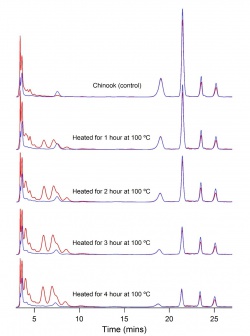
Discussion
There was a qualitative difference between the heat treated hops and the control hops. The treated hops appeared slightly lighter in color, the pellets became softer, and they emitted a strong, pungent, odor. (Figure 4) Data analysis correlating the HPLC chromatograph (figure 2, 3) eluted peak integrations to the concentration of α-acids, and iso-α-acids, in the samples shows a direct time dependent relationship. α-acid concentration decreased in direct relation to how long the particular sample was heated at 100 ⁰C. (Figure 5) & Acid Concentrations in Hops During Heat Treatment
An increase in iso-α-acids was observed (Figure 6) in correlation to the observed reduction of α-acids. (Figure 5)
Figure 6: The conversion of alpha acids to iso alpha acids. The calculations were based upon the changes in integrated areas under alpha acid and iso-alpha acid peaks on chromatographs collected via HPLC. The largest conversion rate was observed within the 1 to 2 hours, with a significantly lower amount of conversion after 2 hours of treatment.
It’s one thing to show that the utilization of hops can be increased by pre-isomerization through heat treatment. However, it’s another to show that this process will produce a usable product. With that in mind the following recipe is our recommendation to small scale brewers interested in testing the pre-isomerization process themselves. Recommendations for Small Scale Brewing Recipe formulations typically use the AAU (Alpha-Acid Unit) to specify the quantity of hops to be added since the %AA (% alpha-acid) changes even within a specific hop variety. The AAU is defined as: AAU = %AA * ounces of hops. For example: A typical American-style pale ale might call for 10 AAU/5 gal. (20 L) as a bittering hop addition. So considering a hop like Chinook with ~13% AA, a 5 gal (20 L) batch calls for ~ 0.8 oz. (22 g) of hop material (AAU/%AA = 10/13 ~ 0.8 oz.). A typical brewing process would add these bittering hops at the beginning of the kettle boil (t = 60 minutes) in order to isomerizes the α-acids. We can convert this α-acid unit to the actual grams of α-acid added to the boil kettle; 13% of 22 g ~ 3 g of α-acid. Typical hop utilization calculators will predict a 30% conversion of the α-acid to iso-α-acid; in this case 30% of 3 g = 0.9 g iso-α-acid in final product after a 60 min boil. Beer bitterness is measured in IBU (International Bittering Unit) which is defined as: IBU = mg iso-α-acid/L In the above example, where 0.9 g (900 mg) of iso-alpha-acid are formed in a 5 gal (20 L) batch, this results in a beer with an IBU = 45 (900/45). When using heat-treated hops (HT-hops), our data suggests that after 3-4 hours of heating at 100 °C in a sealed package, 50% of the alpha-acid is converted to iso-α-acid. So, if we added 0.8 oz. (22 g) of HT-hops to this 5 gal (20 L) recipe, at the very end of the boil, we would be adding 1.5 g (1500 mg), resulting is a beer with an IBU = 75. If we wanted to hit the 45 IBU mark, then this would mean that we would add, not 0.8 oz., but instead ~ 0.5 or a decrease of 40% hop material.
References
- ASBC Methods of Analysis. Hops Method 14. Approved 1990. American Society of Brewing Chemists, St. Paul, MN, U.S.A. doi: 10.1094/ASBCMethod-Hops14
- Danenhower, T. M.; Force, L. J.; Peterson, K. J.; Betts, T. A.; Baker, G. A. HPLC Analysis of - and -Acids in Hops. J. Chem. Ed. 2008, 85(7), 954-956.
- De Keukelleire, D. Fundamentals of Beer and Hop Chemistry. Quimica Nova, 2000, 23(1), 108-112.
- Kappler, S.; Kral, M.; Geissinger, C.; Becker, T.; Krottenthaler, M. Degradation of Iso-a-Acids During Wort Boiling. J. Inst. Brew. 2010, 116(4), 332-338.
- Malowicki, M. G. and Shellhammer, T. H. Isomerization and Degradation Kinetics of Hop (Humulus lupulus) Acids in a Model Wort-Boiling System. J. Ag. Food Chem. 2005, 53, 4434-4439.
- Urban, J.; Dahlberg, C. J.; Carroll, B. J.; Kaminsky, W. Absolute Configuration of Beer’s Bitter Compounds. Angew. Chem. Int. Ed. 2013, 52, 1553-1555.
- Biendl, M. Pre-isomerised Hop Products - Potential and Practical Use. Brauwelt International, 2002, 20–25.


